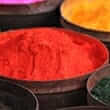Background
- Alizarin has been used as a staining agent for centuries. Originally alizarin vegetable dye was prepared from the madder plant Rubia tinctorum, but now a synthetic preparation is used that is chemically identical. Madder has been regarded as a mild diuretic.
- The Ministry of Health of Russian Federation has approved alizarin as an antiviral preparation for acute and relapsing forms of herpes simplex infection of extragential and genital areas, herpetiform Kaposi's eczema, viral diseases of the oral cavity, herpes zoster and chicken pox in both children and adults.
- Currently, there are no well-established therapeutic uses of alizarin. Precautions should be taken while handling this dye due to the lack of safety data.
References
- Bardin T, Bucki B, Lansaman J, et al. [Alizarin red staining of articular fluids. Comparison of the results with electron microscopy and clinical data]. Rev.Rhum.Mal Osteoartic. 1987;54(2):149-154.
View Abstract - Blomeke B, Poginsky B, Schmutte C, et al. Formation of genotoxic metabolites from anthraquinone glycosides, present in Rubia tinctorum L. Mutat.Res 1992;265(2):263-272.
View Abstract - Brinkworth RI, Fairlie DP. Hydroxyquinones are competitive non-peptide inhibitors of HIV-1 proteinase. Biochim.Biophys.Acta 11-15-1995;1253(1):5-8.
View Abstract - de Ferreyra EC, Villarruel MC, Bernacchi AS, et al. Prevention of carbon tetrachloride-induced liver necrosis by the chelator alizarin sodium sulfonate. Exp Mol.Pathol. 1992;56(3):197-207.
View Abstract - Derksen GC, Lelyveld GP, van Beek TA, et al. Two validated HPLC methods for the quantification of alizarin and other anthraquinones in Rubia tinctorum cultivars. Phytochem.Anal. 2004;15(6):397-406.
View Abstract - Elbadawi A, Musto LA, Lilien OM. Combined alizarin red-reticulum stain for tissue localization of calcium deposits. Am J Clin.Pathol. 1981;75(3):355-356.
View Abstract - Kawasaki Y, Goda Y, Yoshihira K. The mutagenic constituents of Rubia tinctorum. Chem Pharm Bull.(Tokyo) 1992;40(6):1504-1509.
View Abstract - Lorenz D, Lucker PW, Krumbiegel G, et al. Pharmacokinetic studies of alizarin in man. Methods Find.Exp Clin.Pharmacol 1985;7(12):637-643.
View Abstract - Myers HM. Alizarin and tetracycline binding by bone mineral. Am J Phys.Anthropol. 1968;29(2):179-182.
View Abstract - Norton SA. Useful plants of dermatology. IV. Alizarin red and madder. J Am Acad.Dermatol. 1998;39(3):484-485.
View Abstract - Paul H, Reginato AJ, Schumacher, HR. Alizarin red S staining as a screening test to detect calcium compounds in synovial fluid. Arthritis Rheum. 1983;26(2):191-200.
View Abstract - Pharmacological Committee of Ministry of Health of Russian Federation. The Clinical Study of Allizarin. 1998.
- Poginsky B, Westendorf J, Blomeke B, et al. Evaluation of DNA-binding activity of hydroxyanthraquinones occurring in Rubia tinctorum L. Carcinogenesis 1991;12(7):1265-1271.
View Abstract - Rubin PL, Bisk F. Comparative efficacy of differing modes of administering alizarin red S in dogs. Oral Surg Oral Med Oral Pathol. 1969;28(1):122-125.
View Abstract - Westendorf J, Poginsky B, Marquardt H, et al. The genotoxicity of lucidin, a natural component of Rubia tinctorum L., and lucidinethylether, a component of ethanolic Rubia extracts. Cell Biol Toxicol. 1988;4(2):225-239.
View Abstract







